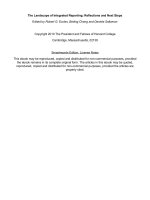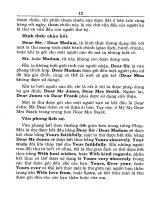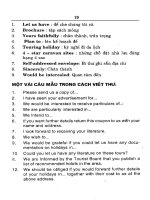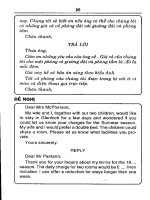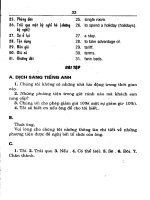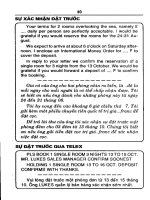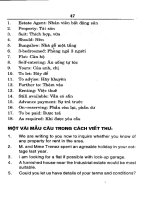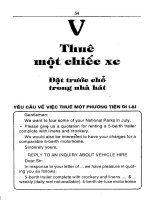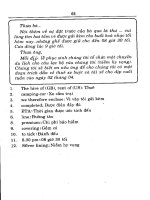Integrated aircraft routing and crew pairing problem by benders decomposition
Bạn đang xem bản rút gọn của tài liệu. Xem và tải ngay bản đầy đủ của tài liệu tại đây (216.01 KB, 58 trang )
INTEGRATED AIRCRAFT ROUTING AND CREW PAIRING PROBLEM
BY BENDERS DECOMPOSITION
LIANG ZHE
(B.Eng.(Hons.) NUS)
A THESIS SUBMITTED
FOR THE DEGREE OF MASTER OF ENGINEERING
DEPARTMENT OF INDUSTRIAL & SYSTEMS ENGINEERING
NATIONAL UNIVERSITY OF SINGAPORE
2003
Acknowledgments
I would like to thank Prof. Huei-Chuen Huang, my supervisor, for her many suggestions
and constant support during this research. Without her, I will not understand linear and
integer programming as today. Also, I learn the attitude of doing research from her, which
will benefit me even more.
I am also thankful to Dr. Li Rongheng and Dr. Alexander David Morton for their help
when I was struggling in understanding Benders decomposition and paper writing.
I had the pleasure of meeting Li Dong, Ivy Mok and Leong Chun How. They are wonderful
people. When we together study linear and integer programming and CPLEX, we shared
our knowledge and help each other. Mr Leong Chun How also shared with me his knowledge
on Airline planning and operations and provided many useful references when I first join the
AirCargo team. Also, I feel so lucky that I can study in ISE together with Li Dong, who
becomes one of my best friends.
Of course, I am grateful to my parents for their patience and love. Without them this
work would never have come into existence.
Finally, I wish to thank the following: Li Rujing (for her cookies); Lin Wei, Zhang
Jun (for playing badminton together); Huang Peng, Sun Hainan, Gao Fei, Liu Bin and Xu
Zhiyong (for taking lunch together).
Liang Zhe
November , 2003
ii
Contents
Acknowledgments
ii
Summary
viii
1 Introduction
1
1.1
Traditional Airline Schedule Planning . . . . . . . . . . . . . . . . . . . . . .
1
1.2
Integrated Planning . . . . . . . . . . . . . . . . . . . . . . . . . . . . . . . .
3
1.3
Research Contribution . . . . . . . . . . . . . . . . . . . . . . . . . . . . . .
3
1.4
Organization of This Thesis . . . . . . . . . . . . . . . . . . . . . . . . . . .
4
2 Literature Review
5
2.1
Aircraft Maintenance Routing Problem . . . . . . . . . . . . . . . . . . . . .
5
2.2
Crew Pairing Problem . . . . . . . . . . . . . . . . . . . . . . . . . . . . . .
9
2.3
2.2.1
Duty . . . . . . . . . . . . . . . . . . . . . . . . . . . . . . . . . . . .
10
2.2.2
Pairing . . . . . . . . . . . . . . . . . . . . . . . . . . . . . . . . . . .
11
2.2.3
Selected Issues . . . . . . . . . . . . . . . . . . . . . . . . . . . . . .
11
Integrated Planning for Maintenance Routing and Crew Pairing Problems . .
14
2.3.1
14
Klabjan et al. (2002) . . . . . . . . . . . . . . . . . . . . . . . . . . .
iii
2.3.2
Cordeau et al. (2001) . . . . . . . . . . . . . . . . . . . . . . . . . . .
15
2.3.3
Cohn and Barnhart (2003) . . . . . . . . . . . . . . . . . . . . . . . .
17
3 Solving the Integrated Model by Benders Decomposition
3.1
20
Benders Decomposition Review . . . . . . . . . . . . . . . . . . . . . . . . .
20
3.1.1
Benders Reformulation . . . . . . . . . . . . . . . . . . . . . . . . . .
21
3.1.2
Benders Decomposition Algorithm
. . . . . . . . . . . . . . . . . . .
23
3.2
Benders Reformulation for Integrated Model . . . . . . . . . . . . . . . . . .
24
3.3
A Feasibility Cut for the Integrated Model . . . . . . . . . . . . . . . . . . .
26
3.4
Amended Benders Subproblem and a New Cut . . . . . . . . . . . . . . . . .
27
3.5
Solving Benders Subproblem and Generating Cuts . . . . . . . . . . . . . . .
28
3.5.1
Checking Feasibility of a Short Connect Set . . . . . . . . . . . . . .
28
3.5.2
Generating CU T 1 . . . . . . . . . . . . . . . . . . . . . . . . . . . . .
29
3.5.3
Generating M IS − CU T . . . . . . . . . . . . . . . . . . . . . . . . .
29
3.5.4
Generating More UM Sets . . . . . . . . . . . . . . . . . . . . . . . .
30
Description of the Solution Procedure . . . . . . . . . . . . . . . . . . . . . .
33
3.6
4 Computational Issues
35
4.1
The Test Problems . . . . . . . . . . . . . . . . . . . . . . . . . . . . . . . .
35
4.2
String and Pairing Generation . . . . . . . . . . . . . . . . . . . . . . . . . .
36
4.2.1
String Generation . . . . . . . . . . . . . . . . . . . . . . . . . . . . .
36
4.2.2
Pairing Generation . . . . . . . . . . . . . . . . . . . . . . . . . . . .
37
Issues in Using CPLEX . . . . . . . . . . . . . . . . . . . . . . . . . . . . . .
38
4.3.1
39
4.3
Memory Problems in Using CPLEX . . . . . . . . . . . . . . . . . . .
iv
4.3.2
Branch On Follow-ons . . . . . . . . . . . . . . . . . . . . . . . . . .
40
4.3.3
Comparison Between Different Data Types . . . . . . . . . . . . . . .
42
5 Computational Result
43
A Small Flight Schedule For Testing
46
v
List of Tables
4.1
Parameters for duty and pairing construction
. . . . . . . . . . . . . . . . .
39
5.1
Comparison between CUT1 and MIS-CUT . . . . . . . . . . . . . . . . . . .
45
A.1 Small Test Case Flight Schedule . . . . . . . . . . . . . . . . . . . . . . . . .
47
vi
List of Figures
2.1
Time Space Network . . . . . . . . . . . . . . . . . . . . . . . . . . . . . . .
6
2.2
Short Connect Example . . . . . . . . . . . . . . . . . . . . . . . . . . . . .
15
vii
Summary
The traditional airline planning is usually divided in several stages and solved sequentially, due to its size and complexity. The early stage results are inputs to the subsequent
stage problems. Therefore, this sequential method may result in sub-optimality in planning.
However, a fully integrated model is not tractable because of its enormous size. Nonetheless,
benefits can be gained by partially integrating elements of the planning process. This paper uses the Benders decomposition to solve the integrated aircraft routing and crew pairing
problem. Reversing the conventional approach, the crew pairing is formulated as the Benders
master problem while a linear program on the selection of an aircraft maintenance routing is
considered as the subproblem. We exploit the structure of the subproblem and identify two
types of feasibility cuts. Test cases are generated to compare these two types of cuts. One of
them is found to be stronger while the other is found to be computationally more efficient.
viii
Chapter 1
Introduction
1.1
Traditional Airline Schedule Planning
The airline planning is usually divided in several stages and solved sequentially, due to its
size and complexity. Airline schedule planning consists of four major steps, which are flight
schedule design, fleet assignment, aircraft maintenance routing and crew scheduling.
The flight schedule (Phillips et al., 1991) is usually determined based on a few factors
like traffic forecasts, airline network analysis and profitability analysis. The schedule is often
built by the airline marketing department and once it is publised it will last for a number of
months.
Given a flight schedule and a set of aircrafts, the fleet assignment problem (Hane et al.,
1995) is to decide which type of aircrafts to fly the flight segments. A fleet type prescribed
by the manufacture is a particular class of aircrafts which has a given seating capacity and
fuel consumption. An airline usually has a variety of fleets. Considering factors such as
passenger demands (both point-to-point and continuing services), revenues, operation costs
1
etc, the fleet assignment faced by the airline is to assign a fleet to each flight of the schedule
so as to maximize the total profit.
Given a fleet assignment solution, a maintenance routing problem (Clarke et al., 1997) is
then solved to determine the individual aircraft rotation, so that enough maintenance opportunities are provided for each aircraft. There are different types of maintenance checks. The
checks differ by the amount of work to be done. For example, Federal Aviation Administration (FAA) requires A, B, C and D checks (FAA, 2002). Type A checks inspect all the major
systems and are performed frequently (every 65 flight hours). B checks entail a thorough
visual inspection plus lubrication of all moving parts, and are performed every 300 to 600
flight hours. C and D checks require taking the aircraft out of service for up to a month
at a time and are done about once every one to four years. Also, different airlines operate
slightly different maintenance regulations. The maintenance routing problem is to schedule
the most frequent maintenances, e.g. A type maintenance, whereas the less frequent, e.g. B,
C and D type of maintenances, can be incorporated into the fleet assignment problem.
The planning process of crew scheduling consists of two steps: crew pairing and crew
rostering. The crew pairing problem (Barnhart et al., 1999) is to determine the best set of
crew pairings to cover the flights. A crew pairing is a crew trip spanning one or more work
days separated by periods of rest. Each cockpit crew is qualified to fly a set of closely related
fleet types, known as a fleet family. Therefore, a crew pairing problem is solved for those
flights assigned to the corresponding fleet family.
The next step, called a rostering problem (Gamache and Soumis, 1998), is to construct
personalized monthly schedules (rosters) for crew members by assigning them pairings and
rest periods.
2
1.2
Integrated Planning
As we can see, the solutions of early stage problems are inputs to the subsequent stages.
Therefore, solving these planning problems sequentially can lead to sub-optimality. However a fully integrated approach to the airline planning process is not tractable, due to its
enormous size and complexity. Nonetheless, benefits can be gained by partially integrating
elements of the planning process. For example, a fleet assignment problem can be solved
incorporating with aircraft routing, crew scheduling or passenger flow considerations.
Particularly in this thesis, we consider the aircraft routing problem together with the
crew pairing problem. One restriction on a valid pairing is that two sequential flights cannot
be assigned to the same crew unless the time between the flights is sufficient (known as
minimum sit time). This minimum sit time can be shortened if the crew follows the plane
turn, which is called a short connect. Even though the difference between the minimum
turn time and the minimum sit time is small, using more short connects in planning can
significantly improve the robustness of the crew scheduling. This is because during the
aircraft disruption, it is possible to absorb the delay in the crew assignment if initially the
crew is assigned to follow the aircraft turn.
1.3
Research Contribution
In this thesis we solve the integrated planning problem by adopting the extended crew
pairing model and approach it by the Benders decomposition. The crew pairing problem is
considered as the master problem while the selection of a maintenance routing out of the
collection of all maintenance routing solutions, which can be treated as a linear program, is
3
solved as a subproblem. We provide insights into the subproblem and identify two types of
feasibility cuts. One of them is a cut generated from a minimally infeasible short connect
set, proposed by Cohn and Barnhart (2003). The other is a cut generated by a maximal
short connect set. The first type of cuts is found to be stronger. However, in solving the
integrated problem it is found to be less efficient computationally.
1.4
Organization of This Thesis
The remainder of the thesis is organized as follows. In Chapter 2, we give a literature
review on the related airline planning problems. Also related models are presented in this
chapter, e.g. the crew pairing problem model, the string model for the aircraft maintenance
routing problem and the extended crew pairing model. In Chapter 3, we give the framework
for the Benders decomposition and identify two types of feasibility cuts. Computational
and implemental issues are addressed in Chapter 4. Chapter 5 concludes the thesis with a
comparison study on the effectiveness and efficiency of solving the integrated problem by the
two types of feasibility cuts.
4
Chapter 2
Literature Review
In this chapter, we first list the previous work done on aircraft maintenance routing and crew
pairing problems. Then we briefly describe three previous research works on the integrated
planning of aircraft maintenance routing and crew pairing problems.
2.1
Aircraft Maintenance Routing Problem
In Figures 2.1, a simple time space network is shown. The schedule contains 2 cities and 12
flights everyday.
In this network, the two horizontal lines represent the time at stations. The vertices of
the network are the flight events on the stations (arrivals and departures of aircraft). The
edge of the network comprised of the flight arcs and the ground arcs. A flight arc represents
a flight between two stations. The ground arcs connect two subsequent flight events on an
airport. We need to make time line a cycle so that the schedule can be circulated (represented
by the dash line).
5
End of Day
S1
S2
Figure 2.1: Time Space Network
After a fleet assignment problem is solved, the time space network for each fleet type is an
Eulerian digraph, i.e. each node has its indegree equal to its outdegree and it is connected.
Clarke et al. (1997) proposed to solve the aircraft maintenance routing problem by forming
an Euler tour in this network, in which all the service violation paths are eliminated. An
Euler tour is a cycle that includes all the arcs exactly once. A service violation path is a
path with length in time longer than the specified service period. By excluding the service
violation path in the Euler tour, the maintenance constraints are satisfied. The objective is
to maximize the benefit derived from making specific connections, which referred as through
value. The problem is solved using the Lagrangian relaxation and subgradient optimization.
Boland et al. (2000) and Mak and Boland (2000) proposed to solve the aircraft maintenance routing problem by modelling it as an Asymmetric Travelling Salesman Problem
with Replenishment arcs (RATSP). A network is built for solving the aircraft maintenance
routing problem by RATSP, where nodes represent flights, arcs represent pairs of flights that
may be connected in sequence and replenishment arcs represent maintenance connections.
In Boland et al. (2000), authors solved the RATSP using a branch-and-bound algorithm.
Mak and Boland (2000) solved the problem using three different types of heuristics. One is a
6
simulated annealing algorithm and the other two are based on the Lagrangian relaxation of
different constraints (subtour constraints and weight limit violation constraints). The result
shows that the algorithm based on simulated annealing performs well overall.
In Barnhart et al. (1998), authors proposed a string model to solve the aircraft maintenance routing problem. A string is a sequence of connected flights that begins and ends
at maintenance stations, satisfies flow balance and is maintenance feasible. The string may
begin and end at different maintenance stations. The model formulates the problem as a set
partitioning problem with side constraints. Formally, the model is given as below.
(M R)
min
cr zr
(2.1)
αf r zr = 1 ∀ f ∈ F
(2.2)
zr − gn+ = 0 ∀ n ∈ N
(2.3)
r∈R
subject to
r∈R
zr + gn− −
r ends at n
r starts at n
gn+ ≤ K
γr zr +
r∈RM
(2.4)
n∈Z M
dr ∈ {0, 1} ∀ r ∈ R
(2.5)
gn+ , gn− ≥ 0 ∀ n ∈ N
(2.6)
where
F : the set of flights
R: the set of feasible route strings
cr : the cost of route string r
αf r : assuming value 1 if route string r covers flight f and 0 otherwise
7
zr : decision variables, assuming value 1 if route string r is included in the solution and 0
otherwise
N : the set of nodes representing points in space and time at which route strings begin or
end
gn− and gn+ : the ground arc variables capturing the number of aircrafts on the ground at
station s immediately prior to and immediately following time t, given a node n that
represents time t at station s
RM : the set of route strings spanning time M , which is an arbitrary time known as the
countline
γr : the number of times string r crosses the countline M
Z M : the set of nodes with corresponding ground arcs gn+ spanning the countline
K: the total number of available aircrafts
The objective function (2.1) minimizes the cost of the chosen route strings. The constraints
set (2.2) are covering constraints, which state that each flight must be included in exactly
one chosen route string. The constraints set (2.3) are balance constraints. Constraint (2.4)
makes sure that the total number of aircrafts in use at time M does not exceed the number
of aircrafts in the fleet. Consequently, the number of aircrafts does not exceed the fleet size
at any time because of constraints (2.3). Constraints (2.5) ensure that the string decision
variable are binary. Thus the integrality of the ground arc variables can be relaxed as denoted
in (2.6).
8
This problem is solved using a branch-and-price algorithm. It is noticed that the time
between any two sequential flights in the string can not be less than the minimum turn time.
This time is used for aircrafts to change gate, clean up and so on.
2.2
Crew Pairing Problem
The airline crew pairing problem is well studied and is often modelled as a set partitioning
problem (Anbil et al., 1992, Barnhart et al., 1999). The model is formulated as follows
(CP )
min
cp yp
(2.7)
δf p yp = 1 ∀ f ∈ F
(2.8)
yp ∈ {0, 1} ∀ p ∈ P
(2.9)
p∈P
subject to
p∈P
where
P : the set of feasible pairings
cp : the cost of pairing p
δf p : assuming value 1 if flight f is included in pairing p and 0 otherwise
yp : assuming value 1 if pairing p is included in the solution and 0 otherwise
The objective function (2.7) minimizes the cost of the chosen set of pairing. The constraints
(2.8) are the covering constraints and (2.9) are the integrality requirement.
The payment structure and the working rules for the airline cockpit crew is complex. In
US airlines, crews are mainly paid for the time they spend in flying; whereas in some other
9
airlines, the crew pay structure may not be exactly the same. In this thesis, we follow closely
with the US pay structure as it is readily available from the journal articles.
2.2.1
Duty
A pairing consists of several duties. A duty is a sequence of flights that can be flown by a
single crew over the course of a work day. There are several constraints to be satisfied when
a duty is constructed. The most obvious constraint is that flights must be sequential in space
and time. The time between any two sequential flights can not be less than a constant time
duration, which is known as minimum sit time. Also, there is a maximum duty time (also
know as maximum duty elapsed time) limitation for a duty. The total elapsed time of a duty
cannot be more than the maximum duty time. Another strict regulation governs the total
number of flying hours (known as block time) that a crew can fly in a single duty period.
The cost of a duty is usually the maximum of three quantities. The first quantity is the
block time. The second is a fraction of the duty elapsed time. The third one is a minimum
guaranteed cost. Formally, the cost of a duty d, denoted as cd , can be expressed as follow:
cd = max{τd × elapse, f ly, mg}
(2.10)
where τd × elapse is a fraction of the elapsed time, f ly is the block time of the duty, and mg
is the minimum guarantee cost. It should be noticed that the start time of a duty is usually
one hour before the departure time of the first flight (this one hour duration is known as
briefing time) and the end time of a duty is usually 15 minutes after the arrival time of
the last flight (15 minutes is known as debriefing time). The duty elapsed time is the time
duration between the duty start time and the duty end time.
10
2.2.2
Pairing
A pairing consists of a sequence of duties and it starts and ends at the same crewbase. In
general, crews spend one to several days away from their homebase. A few constraints have
to be considered when a pairing is built. First, a pairing’s first duty must begin from one
of the crewbases, hence it must end at the same crewbase. Also each duty must begin at
the same airport where the previous duty ends. Similar with the duty, a pairing cannot last
longer than a maximum elapsed time, also known as time-away-from-base (TAFB). Another
very complicated rule is the 8-in-24 rule, which is imposed by the FAA (FAA, 2002). The
basic idea of this rule is if a pairing contains more than 8 flying hours in any 24 hours period,
then extra rest is required.
Similar with the duty cost, the cost of a pairing is the maximum of three values. The
first value is a fraction of the total elapsed time of a pairing. The second value is the sum
of the costs of the duties and the third one is called minimum guaranteed cost per pairing.
The pairing cost is formally expressed as below:
cd , ndp ∗ mg}
cp = max{τp × T AF B,
d∈p
where ndp is the minimal number of duties per pairing, τp is the fraction constant, and
T AF B is the elapsed time of a pairing.
2.2.3
Selected Issues
In this section we discuss a few implemental issues.
11
Pairing Enumeration
Since the cost structure and the constraints are very complicated, pairings are often enumerated before a model is solved. Two different networks are commonly used in enumerating
the crew pairings.
The first network is called duty network (Vance et al., 1997). Duties are first generated
based on the daily schedule. Then a duty network is constructed. Within this network,
nodes represent duties; arcs represent the possible connections between duties. Each duty is
repeated as many times as the number of maximal calender days allowed in a pairing. Two
duties can be connected only when the arrival airport of the first duty is the same as the
departure airport of the second duty and the time in between is a legal overnight rest. It
should be noted that no repeated flight can appear in a pairing in a daily problem. This
can be partially done by ensuring no connects between any two duties if they contain a
common flight. Also, a source and a sink node are included in the network. The source node
is connected to duties that originate at a crewbase. The duties that end at a crewbase is
connected with the sink node.
The second network is known as flight network. Each flight is duplicated as many as the
maximal days allowed in a pairing. In this network, nodes represent the flights and arcs
represent the possible connections between flights. Similar to the duty network, a source
node and a sink node are included in the flight network and connected with flights which
start and end at the same crewbase. Different from the duty network, no duty rules and over
night rests information can be inherited in the flight network. However, the flight network is
good for a large schedule when constructing pairings. This is because the number of duties
12
increases exponentially with the number of flights in the schedule. Consequently, the duty
network is much more complicated than the flight network for a large schedule.
The pairing is constructed by a depth-first search on the duty or flight network. The
search is to extend partial pairings or backtrack. However, when using a flight network, more
checks are needed to ensure that both duty rules and pairing rules are satisfied.
Branching Rules
The number of pairings grows exponentially with the number of flights. Therefore, for
some large flight schedule, we cannot list out all the pairings and branch-and-price is often
employed to get a good crew pairing solution. In the cases even though we can list down all
pairings, it is still critical to engage good branching rule in the branch-and-bound solving
procedure. When branching in solving the crew pairing problem, a useful technique referred
as branching on follow-ons is often employed. This branching rule is motivated by a general
rule for set partitioning problems developed by Ryan and Foster (1981). It is based on
the observation that given a fractional solution to the LP relaxation of a set partitioning
problem, there must exist two columns whose associated variables are fractional such that
they both contain coefficients of one in a common row r and there exists another row s where
one column has a coefficient of one and the other has a coefficient of zero. This fact leads to
a general branching rule where a pair of rows r and s are required to be covered by the same
column on one branch and by different columns on the other. Specifically, when solving the
crew pairing problem, we can branch by requiring that two flights appear consecutively in
pairings at one branch; in the other branch, these two flights cannot appear consecutively in
any pairings. Here, we refer flight pair r, s as a follow-on.
13
2.3
Integrated Planning for Maintenance Routing and
Crew Pairing Problems
Three papers were found to solve the integrated planning for the maintenance routing and
crew pairing problems, which address the effect of short connects. They are discussed below
in more details.
2.3.1
Klabjan et al. (2002)
Klabjan et al. (2002) are the first to address the impact of short connects on the crew
pairing problem. They demonstrate that by considering the short connects in solving the
crew pairing problem, the cost is significantly reduced from the traditional sequential model.
For example, in figures 2.2, there are 4 flights events in a station. If a minimal sit time
is 45 minutes and not short connects are allowed, we can only have a crew connect A → D.
Therefore, we need another crew ready before 8:37 for flight C. However, if we allow short
connects in the crew schedule, we could have crew connects A → C and B → D. This could
save the cost potentially.
In Klabjan et al. (2002), the planning problems are solved in reverse order. They first
solve the crew pairing problem assuming all the short connects are valid. A set of constraints
are added to the original crew pairing model to ensure that the number of the aircrafts
used at any short connection period is not more than the fleet size. Then they solve a
maintenance routing problem to incorporate the short connects selected in the crew pairing
solution. This approach can lead to maintenance infeasibility. However, in practice they
find feasible solutions for some hub-and-spoke flight networks using this approach. As long
14
D
C
8:00 8:20
8:37
A
9:00
B
Figure 2.2: Short Connect Example
as the maintenance routing problem is feasible, the solution for the crew pairing problem
is optimal for the integrated problem. This method requires no more computational effort
than the traditional sequential method.
Here, the aircraft maintenance routing problem is considered to be a feasibility problem,
since no costs are involved. This is reasonable because the running cost of aircraft is more
or less determined at this planning stage, which takes place after the schedule design and
fleet assignment stages.
2.3.2
Cordeau et al. (2001)
Cordeau et al. (2001) present a basic integrated model for the maintenance routing and crew
pairing problems, which guarantees the maintenance feasibility. The maintenance routing
cost is explicitly considered in this model. The authors assume a dated planning horizon in
which the set of flights may vary from day to day. Here, we modify their model slightly to
15
cater for daily problems. The basic integrated model is formulated as below.
(BIM )
min
cp yp +
p∈P
cr zr
(2.11)
r∈R
subject to
δ f p yp = 1 ∀ f ∈ F
(2.12)
αf r zr = 1 ∀ f ∈ F
(2.13)
zr − gn+ = 0 ∀ n ∈ N
(2.14)
p∈P
r∈R
zr +
r ends at n
gn−
−
r starts at n
gn+ ≤ K
γr zr +
r∈RM
ϑtr zr −
r∈R
(2.15)
n∈Z M
ηtp yp ≥ 0
∀t∈T
(2.16)
dr ∈ {0, 1} ∀ r ∈ R
(2.17)
gn+ , gn− ≥ 0 ∀ n ∈ N
(2.18)
yp ∈ {0, 1} ∀ p ∈ P
(2.19)
p∈P
where besides the notations defined in section 2.1 and 2.2,
T : the set of all possible short connects
ϑtr : assuming value 1 if string r contains short connect t and 0 otherwise
ηtp : assuming value 1 if pairing p contains short connect t and 0 otherwise
Objective function (2.11) minimizes the cost of chosen pairings and strings. Constraints
sets (2.12) and (2.19) are the same as in CP model. Constraints sets (2.13)-(2.15), (2.17) and
(2.18) are the same as in MR model. The two models are linked by constraints set (2.16),
which ensure that a short connect is selected in a crew pairing only when it appears in the
maintenance routing solution.
16
Here, crew pairings are constructed with all potential short connects allowed. This model
results in a large-scale integer program. The model is solved using a Benders decomposition
approach coupled with a heuristic branching strategy, in which the maintenance routing is
considered as the master problem while the crew pairing as the subproblem.
2.3.3
Cohn and Barnhart (2003)
Cohn and Barnhart (2003) proposed an extended crew pairing model integrating crew pairing
and maintenance routing decisions. As in Cordeau et al. (2001), to ensure the maintenance
feasibility, the two decisions are linked by short connect constraints. The same constraint
appears in Klabjan et al. (2002), but their model does not consider the maintenance routing
cost explicitly. The decision on the maintenance routing is captured as a problem of choosing
one out of all the feasible maintenance routing solutions. Formally, the model is formulated
below.
(ECP )
min
cp yp
(2.20)
p∈P
subject to
δf p yp = 1 ∀ f ∈ F
(2.21)
ηtp yp ≥ 0 ∀ t ∈ T
(2.22)
p∈P
βts xs −
s∈S
p∈P
xs = 1
(2.23)
s∈S
xs ∈ {0, 1} ∀ s ∈ S
(2.24)
yp ∈ {0, 1} ∀ p ∈ P
(2.25)
where the additional notations are
17
